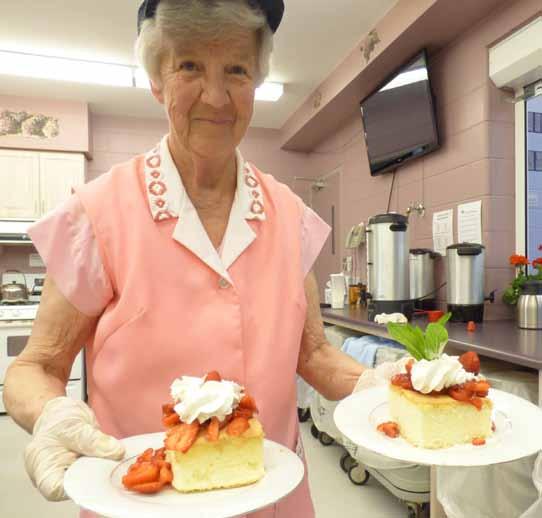
4 minute read
Auxiliary Ready To Get Back In Swing
CONTINUED FROM PAGE 62
“The community has always been so supportive of the things we do,” says Jill, “and we really appreciate it.”
Advertisement
The Strawberry Teas, held in mid-June, were initially held on the front lawn of the Barbours’ Main Street East home - surrounded by lush gardens and continued there into the mid-1990s. The event was later moved to the garden of one of the town’s doctors on Kerman Avenue and, most recently, has been staged at St. Andrew’s Anglican Church hall.
Antique shows and fashion shows were also some of their biggest fundraisers, Judy says. They’re currently on hold just as last Christmases poinsettia sale, but she, Jill and Barb are all looking forward to their return, as well as the popular lasagna dinners.
Jill hopes to see a return of the wine event (“Those are really great”) and the Santa family breakfasts. “That connects us with a different age group,” she says, “and that’s really important.”
There have been changes to their events and programs over the decades, she adds, most of which were responding to changing times.
“At one point we realized the days of the bazaar had passed,” she says. The same thing applies to the items in the gift shop. “But we’re lucky to have people with a wide range of skills.”
While hospital equipment is the most visible of their efforts, there are also what Jill calls “the niceties of things — the added care”, such as transporting patients, helping them from their rooms to the physiotherapy rooms and even things like manicures - just to lift the spirits. Another highlight is the annual recognition of the year’s first baby born at WLMH.
“We’re willing to take on whatever’s asked of us,” she says, adding that the Auxiliary serves only WLMH. “Any money we raise, it stays right here.”
A Memorial Fund was started in 1962, and around the same time, Barb remembers, the memorial room … officially called the “Quiet Room” … was also set up.
“We provided the furnishings for it,” she says. It was a place where family members could speak with healthcare workers in some privacy, rather than having to stand out in the hallway. The Quiet Room was open for a decade or so.
Back in the day, people were often in the hospital for longer periods of time than today, so the Auxiliary also set up a TV rental system. It gave people something to do besides lie in bed and look at the walls all day, Barb says.
She also mentioned the Twig Program.
“The community was very involved in that,” she says. “It encompassed all the fundraising that the Fundraising Committee didn’t do, such as the sale of cookbooks, Tag Day, bake sales, and so on.”
One thing she hopes to see back soon is the Marathon Bridge fundraiser, which gave newcomers a good way to meet not only Auxiliary members but people in town in general. In fact, that’s how she got started with the Auxiliary.
Jill was on the first redevelopment committee and remembers being “really shocked” when it all fell apart. “But this time, we’re good!” she says. “This time next year we’ll have a hole in the ground.”
What is it that they like about being involved with the Auxiliary?
“I like being involved with the patients,” says Judy, “but also the friendships you make. I like being able to help others, but also feeling appreciated. The hospital staff appreciates all the help you can give them regardless of how much money or time you can give.”
For me, it’s giving back to the community,” Jill says. “It gives you a personal sense of accomplishment when you can help someone or when the Auxiliary can buy a piece of equipment for the hospital and you know you’ve had a hand in that — when you are working with a vision and a goal, and working for the common good.”
“What I really like is the sense of community,” Barb says. “We’d meet with other auxiliaries in the area and get lots of ideas from other people. We’d share problems and find solutions.”
She was also involved with Auxiliaries at the provincial and national levels over the years, and those were even more invigorating. “We got to exchange ideas with people not just from across the province, but across the country.”
As the Auxiliary’s historian, Barb works hard to collect news articles, photos and other memorabilia. The bulk of it is stored in the current hospital building, and “we must decide what to do with it when the new hospital is built,” she says. At present she’s working on chronicling artifacts - from dedicated benches to plaques to photos and awards.
So when will the volunteers be able to get back to work?
“It’s just a matter of when the hospital gives the okay,” Judy says. “There might be changes — volunteers might need to get COVID shots — but we’ll accept them.”
Like the others, she’s waiting to see the first steps in the construction of the new hospital. “I’m excited to see the hole in the ground. Then I’ll know it’s on its way.”






